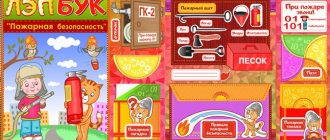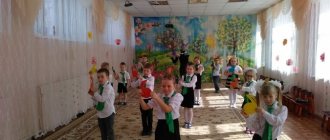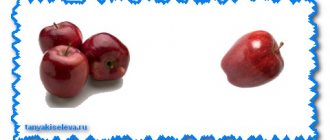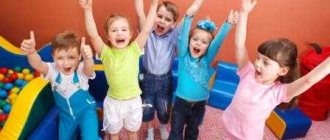Teaching numeracy, systematized and methodologically justified by the Federal State Educational Standard (FSES), is included in the system of work with preschoolers in kindergarten. However, the age characteristics of children require particularly careful preparation of visual aids. The most important role is given to the counting material. We will look at the types of counting material used in mathematics classes in different age groups, and give advice on how to make it yourself as a demonstration and handout.
- 2 Features of demonstration and handout material for different age groups
2.1 Types of handouts2.1.1 Photo gallery: examples of counting handouts
- 3.1 How to make didactic materials for the preparatory group with your own hands
3.1.1 Photo gallery: example of a homemade laptop
- 4.1 Photo gallery: examples of individual cards and a picture for a mobile folder
- 5.1 Photo gallery: individual cards for the senior group
The validity of using visual counting material in kindergarten
In a preschool educational institution, children begin to master counting at the age of three, and this is their main mathematical activity. Learning takes place with the indispensable support of visual aids, since abstract logical operations performed during counting (merging and dividing sets, comparing quantities and numbers, comparing sets) are difficult for children to understand and require “objectification.” Visual counting material is a comprehensive didactic tool aimed at developing basic ideas about counting as part of targeted learning.
Famous teacher K.D. Ushinsky said: “Children’s nature itself requires visual learning.”
Such benefits are very diverse, and their application in each case depends on:
- specific content of educational material (for example, teach children of the second youngest group to distinguish between the concepts of many and few);
- methods used (more precisely, certain gaming techniques, for example, illustrations for a fairy tale in which characters learn to count);
- the age of the children (if in the second younger group there may be cards with pictures of the same animal, then in the older group the pictures depict different animals, that is, the essence of the phenomenon being described becomes more complex).
Counting in kindergarten is mastered along with other didactic skills and concepts, for example, learning about colors: distribute the mushrooms into baskets of the corresponding colors and say which one has more/fewer of them
Visual material must meet the following requirements:
- scientific (correspond to scientific data on counting);
- pedagogical (carry an educational, developmental, educational load);
- sanitary and hygienic (do not contain harmful substances, do not cause eye strain;
- aesthetic (beautiful design, bright and clear images)
Why study self-esteem?
Self-esteem is a very important indicator in personality development. This is how a person evaluates himself, his qualities, and abilities.
Self-esteem is formed in the process of communication and activity; it influences a person’s behavior and actions in a given situation.
At preschool age, a child is just beginning to recognize himself, mainly from the assessments and opinions of others, which may not always be correct and correspond to reality. This results in inadequate self-esteem, which can be either underestimated or overestimated.
Any distortions entail difficulties in further communication and activities, so it is important to monitor and correct them in a timely manner. One of the ways to study self-esteem is the “Ladder” technique by V.G. Shchur.
Features of demonstration and handout material for different age groups
Calculating material in mathematics, like other visual aids, can be of two types:
- large, that is, demonstration, which is used by the teacher to explain and show how to operate with it (magnetic boards, posters, paintings, etc.);
- small, that is, handout (cards, laptops, etc.), using which all children perform certain tasks at the same time, which allows organizing independent activities of children to develop the necessary mathematical skills and abilities.
Visual mathematical material differs in the type of counting activity, which is a priority for a specific age category.
- Second junior group. To form the concept of singularity and multiplicity, you can use, for example, puzzle pictures, cubes in which numbers are surrounded by elements with the same number of fruits (vegetables, animals, etc.) or pictures with dots that need to be correlated with the number. By the way, the same material with dots is still used, only there are more numbers.
- Middle group. Children must be able to give an accurate assessment of a set of objects, in this case counting to 5. For this, pictures depicting objects and numbers corresponding to their quantity are actively used, as well as a combination of a toy and a three-dimensional number. For example, to recognize the graphic image of a number, the task could be as follows: help the bunny find the number 3. Place a moth on a flower with five petals.
- Senior group. Kids count to 10 and can add or subtract one at a time. For clarity, they use, for example, the game of dominoes, matching a number with a picture with the same number of objects.
- Preparatory group. Children can compare numbers “more and less”, and make up given numbers from two smaller ones - 5 from 2 and 3, for example. The demonstration material becomes more complex. These could be tasks for comparing the number of objects in pictures, composing a whole image after sequentially folding numbered cut parts, etc.
Counting sticks are a universal visual aid: they allow you to demonstrate and practice all types of counting activities.
Thus, the first manuals are aimed at ensuring that children learn to correlate the visual image of a number and the number of objects it denotes. In the middle group, this work is no longer on “recognizing” the image of a number, but on quantitative counting up to 5. In the older group, children learn to perform basic addition and subtraction operations, and in the preparatory task materials are comparative in nature, since children already know how to correlate quantities , indicated by numbers.
At any stage of training, it is necessary to think over a way to get acquainted with the graphic image of a number, for example, in the form of creating an application
Types of handouts
As already mentioned, manuals can be demonstration or handout. And there are also those that can be used in both cases (for example, Dienesh blocks). The teacher chooses the types of handouts depending on the age of the children. So, already in the first junior group, children get acquainted with cubes and counting sticks. True, so far the assessment level is “a lot or a little.” Typically, the gradation of the use of types of handouts depends on the age of the children: the younger, the more toys, and the older, the more drawings and diagrams. In general, the following counting aids are actively used in kindergarten:
- Cuisenaire sticks (multi-colored parallelepipeds of different sizes made of wood or plastic are used mainly in the second junior and middle groups, when the concept of quantity is introduced);
- Dienesh blocks (a set of geometric shapes of different sizes, which can be used by analogy with Cuisenaire sticks, as well as to introduce rectangles, triangles, circles, squares);
- cubes (in the younger group they practice the concepts of “many and few”);
- pyramids (as a budget, more affordable version of Cuisenaire sticks and Dienesh blocks);
- beads, buttons (in junior and middle groups);
- pictures, puzzle pictures, cards (for all ages);
- fan with numbers (for senior and preparatory groups, in which the children already clearly associate a number with its graphic image);
- lapbooks, tasks in which can combine all of the above manuals, etc.
Please note that there is no clear age division in the use of counting materials, since their use must be justified from the point of view of the educational goal. And yet, in the senior and preparatory groups, the emphasis is on cards, so that children get used to working with clarity “like at school.”
Photo gallery: examples of counting handouts
The capabilities of counting cubes allow them to be used up to the preparatory group
To master the skill of counting to 5, it is convenient to use special pyramids
A fan with numbers is a tool for school, but can also be used in kindergarten
Using blocks you can practice mastering basic geometric shapes and counting objects in groups
You can learn to count on sticks completely unnoticed: for example, by laying out figures from them
Lapbook for FEMP “Quantity and counting”
A laptop is a folder that contains material on a specific topic. The organization of the material in such a manual is that the teacher arranges the visualization in the form of mini-books, accordion layouts, gift boxes, windows or pockets, etc. In addition, the lapbook necessarily includes tasks of a creative nature.
Lapbooks are also used to form elementary mathematical concepts (EMPs) - the fruits of the teacher’s creative approach to the implementation of learning tasks. Benefits are calculated for a specific stage of training. Since lapbooks were originally made by parents to teach their child, these manuals, put on a “methodological stream,” are now used for individual work, as well as for working in pairs or threes.
How to make didactic materials for a preparatory group with your own hands
First, you need to determine the goals of the Quantity and Counting lapbook.
- Strengthen the ability to count to 10.
- Practice ordinal and quantitative counting.
- Practice the skill of comparing numbers with the number of objects.
- Learn to write numbers.
- Develop the ability to add, subtract and compare numbers within 10.
- Develop active vocabulary, logic, memory and thinking.
- Work on the ability to independently solve assigned problems.
- Cultivate responsiveness, self-confidence and self-confidence.
After the organizational stage, you can proceed directly to production. This process begins with the preparation of the necessary materials. Moreover, methodological questions are developed first, and only then a suitable design is selected for them.
Typically a lapbook includes:
- pictures with numbers for visual perception of their graphic image;
- cards with numbers and objects (either separately or 2 in 1);
- puzzles (cut numbers or pictures, each piece of which shows a number, etc.);
- pictures of fairy tales with numbers in their titles;
- coloring books;
- copybook;
- riddles, counting rhymes, etc.
It is most convenient to organize materials into files, which, in turn, are stored in a folder. The cover of this manual frame should also be brightly designed. But with such packaging, it is troublesome to work with the materials: before use, part of the manual will have to be laid out. So you can take advantage of the experience of your colleagues and make the pages of the lapbook cardboard, and on these sheets you can attach files, pop-up books, and boxes with surprises.
Photo gallery: example of a homemade laptop
For a lapbook, using a binder is the most durable
Cards with dots and numbers can be placed in bright envelopes so that the baby becomes interested in their contents
When producing such a manual, it is assumed that children know how to write
By laying out numbers from elements, children remember the graphic image of numbers and also train their eye
With the help of a lapbook, children quickly and easily understand the essence of comparison
Having solved the example on the garage and on the car, the child must correlate the same answers
Children, as a rule, get excited about playing dominoes.
Drawing conclusions
After the test, the data obtained is interpreted. First of all, they look at what level the child has placed himself on.
- The first, the highest, most often indicates inflated self-esteem. Especially if the child does not give any reasons for his choice, but simply believes that he is the best, because his mother said so. Although you need to understand that for preschool children, high self-esteem is considered normal, because they are not yet able to adequately evaluate themselves and mainly rely on the opinion of adults, who usually at this age treat them with adoration, regardless of their successes or failures.
- If a child puts himself on the second or third rung of the ladder, it means he has adequate self-esteem. He treats himself well and can even give examples of his merits and good deeds.
- The fourth step is chosen by children with slightly low self-esteem. It is important to find out why they make these choices. Perhaps there are problems that concern the child. Or the fourth, middle step may be a way to demonstrate their reluctance to complete the task, or they simply do not understand what needs to be done.
- Children with low self-esteem place their figure on the fifth and sixth steps. An adult should definitely talk with the child to understand whether the identified self-esteem is situational, temporary, associated with some recent unpleasant event, or whether the child really has a negative attitude towards himself. Knowing the reasons allows you to work on the problem.
- And finally, choosing the lowest, seventh step indicates a sharply low self-esteem. This is a signal about the child’s troubles, about his negative attitude towards himself, uncertainty, maladjustment. This means that the situation in the kindergarten, at home, or both is unfavorable. These children primarily need help.
Equally important for interpretation are the positions in which adults would place them, in their opinion. This information will show a picture of the preschooler’s relationships with close adults. If one of them puts him on the highest step, it means that the child feels that he is loved. If it’s lower, then you need to figure out what the problem is and work on it together with parents and educators.
The relationship between mother and child is considered the most important, therefore, when processing diagnostic data, attention is paid to this relationship of positions. If a child’s opinion of himself is higher than his mother’s, this means that he does not feel her love and support.
A controversial situation is when the figure “for itself” and “for mother” ends up on the same rung of the ladder. Sometimes this is done by children who feel their mother’s not very favorable attitude, but do not want to admit it, so they wishful thinking.
But perhaps the preschooler just did this and cannot explain how he and those around him really evaluate himself. Therefore, it is very important to have a conversation, ask questions, and understand each specific situation.
But the best option, in the opinion of the author of the method, is the case when the mother would place the figure on the highest step, and the child himself would be slightly lower - one or two positions. This shows the mother’s positive attitude and the child’s objective view of himself. He feels the love of a loved one, the confidence that he is good, although he sees some of his shortcomings.
Upon completion of the diagnosis, a certificate is drawn up on the methodology performed, which will show the presence of problems with self-esteem in preschoolers and help determine a plan for further action.
Individual cards in mathematics for the second junior, middle, senior groups
Learning to count is something that requires maximum concentration and constant practice from a child. The latter is designed to provide individual cards - methodological aids for working on a topic one at a time or in mini-groups (2-3 people).
- In the second younger group, to practice the concept of one-many, for example, a card may have a picture of a steam locomotive. The child receives a stack of trailers and distributes them according to the card. At the same time, the adult focuses the child’s attention on the fact that at first there were no carriages, then one appeared, and then “many.”
- In the middle group, counting to 5 is very effectively trained by correlating elements of pictures (for example, dots on the back of a ladybug) and a graphic image of the number.
- In the older group, to practice counting to 10, you can use tables with dots and small cards with numbers that children must correlate with each other. Or cards with numbers to restore counting order. By the way, the skill of writing numbers is trained in the same way.
- In the preparatory group, the cards can be graphic examples of addition and subtraction: the child counts the number of objects to the left of the + or - sign and writes the result in the cell provided for this.
For practical reasons, it is better to laminate cards. Then, even if the child needs to write something on an assignment (for example, the answer to the solution to an example), he will be able to do it with a marker that can be easily wiped off the cellophane.
To ensure that the numbers are always in the children’s field of view, you can install a “Fun Counting” folder in the group. She will introduce the kids to both numbers and the number of objects in a group.
Photo gallery: examples of individual cards and a picture for a mobile folder
In the younger group, kids learn to evaluate sets by attaching different numbers of cars to locomotives
In the preparatory group, children perform addition and subtraction in the range from 1 to 10
A child in the middle group must count the spots on the back of a ladybug and connect it with the appropriate number.
In the older group, children learn to perform simple arithmetic operations ranging from 1 to 10
Bright and beautiful pictures from the mobile folder will attract the attention of the children and teach them to correlate the number with the number of objects
Pictures for teaching counting in senior and preparatory groups
There are no particular differences in the form of the pictures, only the tasks, that is, the content, differ.
Photo gallery: individual cards for the senior group
Number cards can be made at home
By rearranging the number of balls, the child will learn to count to 10, as well as sort things according to the “new/old” principle.
An individual card may contain a creative task: sculpt a number from plasticine
Such houses help children learn the composition of numbers
It is worth noting that the cards do not always represent a drawn/pasted image. An individual card may consist of individual elements that are laid out on a sheet. A kind of overlay applique.
Photo gallery: counting aids for the preparatory group
This is how children are presented with the principle of variability of terms with the same amount
This is a dynamic card, that is, it comes with a pocket with balls with examples, as well as cards with answer numbers
In the preparatory group, children easily cope with the task of writing down the neighbors of the numbers in the windows of the house
This guide not only trains math skills, but also develops fine motor skills.
Demonstration counting material is a manifestation of the teacher’s imagination, aimed at ensuring that children learn the basics of mathematical operations while playing. Lapbooks have proven themselves very well, as the children enjoy playing with such large applications, which include pictures, puzzles, and coloring books. When preparing this manual, two important points must be taken into account: the laptop must be strong, that is, not crumble during use, and entertaining, so that with its help the teacher can realize the set training, developmental and educational goals.
Visual aids for teaching mathematics to preschool children
author: Kabirova Alina Valerievna
teacher MBDOU kindergarten No. 23
Visual aids for teaching mathematics to preschool children
THE ROLE OF VISUAL Aids
FOR TEACHING MATHEMATICS TO CHILDREN OF SENIOR PRESCHOOL AGE
Kabirova A.V.
MBDOU No. 23
The development of the intellectual abilities of preschool children is one of the pressing problems of our time. Teaching mathematics in modern life is becoming increasingly important. Teaching preschoolers the basics of mathematics should be given an important place. This is caused by a number of reasons: the beginning of schooling at the age of 7, the abundance of information received by the child, increased attention to computerization, the desire to make the learning process more intense, and the desire of parents in this regard to teach the child to recognize numbers, count, and solve problems as early as possible. The main goal is being pursued: to raise children as people who can think, navigate well in everything that surrounds them, correctly assess the various situations they encounter in life, and make independent decisions. The main effort of parents and teachers should be aimed at instilling in a preschooler the need to be interested in the process of cognition itself, in overcoming the difficulties standing on this path, in independently finding solutions and achieving the goal. In mathematics classes in kindergarten, the simplest types of practical and mental activities. It is very useful to use interesting, colorful, understandable visual material for children in classes on the formation of elementary mathematical concepts, since with the help of it the child remembers and assimilates knowledge better. Visualization helps to better perceive what the teacher is teaching the child about. Didactic material in classes on the formation of elementary mathematical concepts activates, interests children, and gives them a positive emotional mood. Preschool children show spontaneous interest in mathematical categories: quantity, shape, time, space, which help them better navigate things and situations, organize and connect them with each other, and contribute to the formation of concepts. By conducting a lesson with interesting, fascinating, entertaining visual material, the teacher contributes to the formation of the necessary elementary mathematical concepts.
In preschool age, the foundations of the knowledge a child needs in school are laid. Mathematics is a complex subject that can present some challenges during schooling. In addition, not all children are inclined and have a mathematical mind, so when preparing for school it is important to introduce the child to the basics of counting. In mathematics, it is not the quality of objects that is important, but their quantity. Operations with numbers themselves are still difficult and not entirely clear to children. However, you can teach your child counting using specific subjects. The child understands that toys, fruits, and objects can be counted. At the same time, you can count objects “in between times.” For example, on the way to kindergarten, you can ask your child to count the objects you meet along the way. It is known that children really like doing small housework. Therefore, you can teach your child to count while doing homework together. For example, ask him to bring you a certain amount of any items needed for the business. In the same way, you can teach your child to distinguish and compare objects: ask him to bring you a large ball or a tray that is wider. When a child sees, feels, touches an object, it is much easier to teach him. Therefore, one of the basic principles of teaching children the basics of mathematics is clarity.
How people learned to count.
No one knows how the number first appeared, how primitive man began to count. However, tens of thousands of years ago, primitive man collected the fruits of trees, went hunting, fished, learned to make a stone ax and knife, and had to count various objects that he encountered in everyday life. Gradually, the need arose to answer vital questions: since everyone will get enough fruit, so that there is enough for everyone, how much to spend today in order to leave it in reserve; how many knives need to be made, etc. Thus, without noticing, the man began to count and calculate.
At first, man learned to identify single objects. For example, from a pack of wolves, a herd of deer, he singled out one leader, from a brood of chicks - one chick, etc. Having learned to single out one object from many others, they said: “one”, and if there were more of them - “many” Even for the name the numbers “one” were often used with a word that denoted a single object, for example: “moon”, “sun”. This coincidence of the name of an object and a number has been preserved in the language of some peoples to this day.
Frequent observations of sets consisting of a pair of objects (eyes, ears, wings, hands) led man to the idea of the number two. To this day, the word “two” in some languages sounds the same as “eyes” or “wings.”
“If there were more than two objects, then primitive man said “many.” Only gradually did man learn to count to three, then to five and to ten, etc. Naming each number with a separate word was a great step forward.
People used their fingers and toes to count. After all, small children also learn to count on their fingers. However, this method was only suitable within 20.
A solution was found: count on your fingers to 10, and then start over, separately counting the number of tens. The ten-based number system arose as a natural development of finger counting. With the help of their fingers, people learned not only to count large numbers, but also to perform addition and subtraction operations.
A set of visual aids, developed and produced by me for children in the pre-school group, will help them actively master addition and subtraction in older preschool age.
A set of visual aids.
Nowadays, hardly anyone will be surprised by the pocket calculator that we use every time we need to quickly and accurately make some calculations. Before the calculator, arithmometers were used for calculations - mechanical adding machines, abacus, counting sticks. The oldest calculating instrument given to man by nature itself was his own hand. In order to simplify the task of clearly explaining to a child, I offer the “Finger Counting” manual.
With the help of the “Finger Counting” manual, children will be able to visually perform mathematical manipulations of addition and subtraction by bending and straightening their fingers.
Manual "Calculator"
The “Calculator” manual clearly presents solutions to addition problems and examples.
For example: take 2 plums, add 2 more plums to it. How many plums did we get in total?
Place 2 plums in the first tray of the calculator, and two in the second. Now let's look into the chest, how much did we get?
Correct: 2 more plums were added to 2 plums, resulting in 4 plums. This can be written like this: 2 + 2 = 4. Instead of the word added, this “+” sign is written. It's called "plus". The word “will work out” is also replaced with the sign “=”. It's called "equal". So, we wrote down an example that reads like this: “Add two to two equals 4” or “two plus two equals four.”
Children do similar work on creating an example at tables with various handouts. They learn to write and read an example.
Manual "Mathematical beads"
With the help of this manual, consisting of wooden or plastic beads on a cord, a child can easily learn to count the required number of beads, as well as add them, subtract them and, as a result, solve examples and visually represent the composition of a number.
Thus, the manuals presented above greatly facilitate the method of teaching addition and subtraction to children of senior preschool age. The use of visualization in mathematics leads to the formation in children of good computing skills, mental development and preparation for learning at school, and also helps the teacher in individual work with children.





